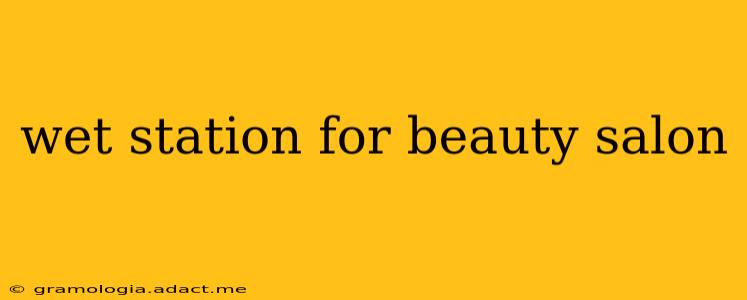A well-designed wet station is the heart of any successful hair salon. It’s where the magic happens, transforming clients’ looks and enhancing their experience. But creating the ideal wet station goes beyond simply placing shampoo bowls and chairs. It requires careful planning and consideration of ergonomics, hygiene, and overall salon aesthetics. This guide will explore everything you need to know about designing and equipping a functional and stylish wet station.
What is a Wet Station in a Hair Salon?
A wet station is the dedicated area in a hair salon specifically designed for hair washing and conditioning. It typically includes shampoo bowls, styling chairs, and storage for shampoos, conditioners, and other necessary products. The wet station's design is crucial for both client comfort and stylist efficiency. A poorly designed wet station can lead to discomfort for clients, inefficiencies for stylists, and even safety hazards.
What are the Essential Components of a Wet Station?
Several key components contribute to a high-performing wet station:
Shampoo Bowls:
- Comfort: Choose bowls that offer comfortable neck support for clients to prevent strain during the washing process. Ergonomic designs are essential. Consider options with adjustable height and tilt.
- Durability: Opt for durable, easy-to-clean materials like ceramic or high-quality plastic. Stainless steel is also a popular choice for its longevity and hygiene.
- Water Temperature Control: Ensure the bowls are fitted with easy-to-use controls for precise water temperature regulation, catering to individual client preferences.
Styling Chairs:
- Ergonomics: Stylists spend considerable time at the wet station, so comfortable and ergonomic chairs are crucial. Look for adjustable height and tilt options to minimize strain and promote good posture.
- Durability and Cleanability: Similar to the shampoo bowls, choose durable and easily cleanable materials. Water resistance is paramount.
- Matching Aesthetics: Select chairs that complement the overall salon design and the shampoo bowls for a cohesive look.
Plumbing and Water Management:
- Efficient Drainage: A well-designed drainage system prevents water from pooling, reducing the risk of slips and falls. Consider a floor drain near the wet station.
- Water Pressure: Ensure adequate water pressure to provide a comfortable and efficient hair washing experience.
- Water Temperature Regulation: Invest in a system that provides consistent and easily adjustable water temperature.
Storage:
- Accessibility: Keep shampoos, conditioners, and other products easily accessible for stylists, ideally within arm's reach. Utilize shelves, drawers, and cabinets to maximize storage space.
- Organization: Implement an organized storage system to prevent clutter and facilitate quick access to specific products. Label containers clearly.
- Hygiene: Ensure all storage units are easy to clean and maintain a hygienic environment.
How Much Space Do I Need for My Wet Station?
The space required for your wet station will depend on the number of shampoo bowls you intend to install and the overall layout of your salon. Allow ample space between bowls to ensure stylists can move comfortably and clients have privacy. Consider allowing at least 4-5 feet of space between each shampoo station. A larger salon might require a dedicated wet room.
What are the Different Types of Wet Stations?
Several types of wet stations cater to different salon needs and budgets:
- Traditional Wet Stations: These feature individual shampoo bowls and chairs arranged in a row or in a semi-circular configuration. They are common in many salons due to their practicality.
- Back-to-Back Wet Stations: This design is space-saving and efficient, allowing two stylists to work simultaneously.
- Modular Wet Stations: These offer flexibility and customization, allowing you to configure the stations to suit your specific salon layout and needs.
How to Maintain Hygiene at the Wet Station?
Maintaining hygiene is paramount in a salon setting. Follow these best practices:
- Regular Cleaning: Clean and disinfect shampoo bowls and surrounding surfaces after each client.
- Disinfectant Use: Use salon-grade disinfectants to kill germs and bacteria.
- Proper Towel Management: Ensure clean, fresh towels are used for each client and that used towels are properly laundered.
- Airflow: Good ventilation is crucial to prevent mildew and mold growth. Consider an exhaust fan.
What are the Latest Trends in Wet Station Design?
Current trends in wet station design emphasize both functionality and aesthetics:
- Modern Minimalist Designs: Clean lines, neutral colors, and sleek materials are popular choices.
- Ergonomic Features: Emphasis on client and stylist comfort through adjustable features.
- Sustainable Materials: Increasing use of eco-friendly and sustainable materials.
- Integrated Technology: Incorporating features like built-in lighting and water filtration systems.
By carefully considering these factors, you can create a wet station that is not only aesthetically pleasing but also highly functional, promoting both client satisfaction and stylist efficiency. Remember, a well-designed wet station is an investment in your salon's success.
